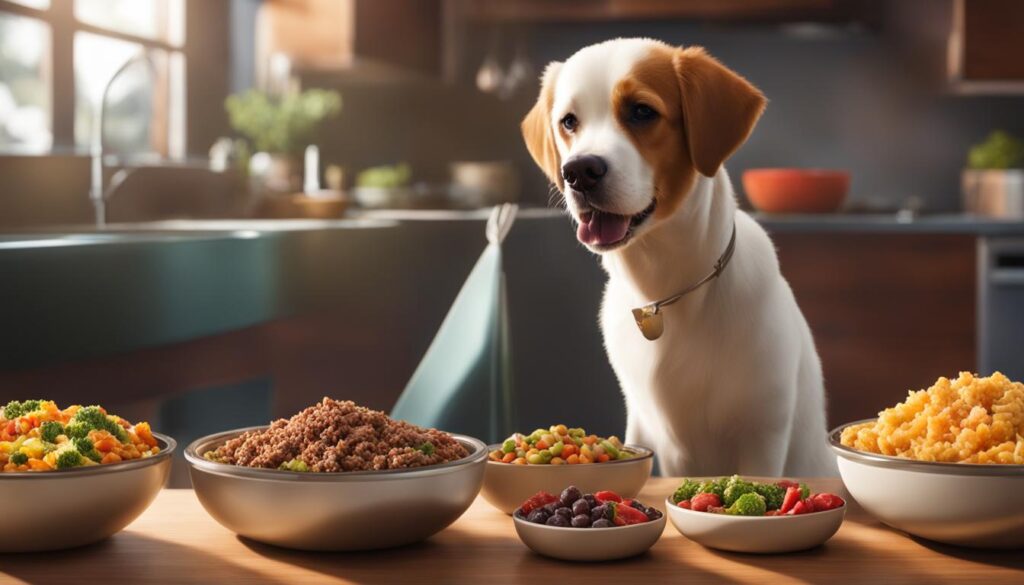As a journalist specializing in pet science, I am frequently asked about dogs’ sense of taste and their ability to perceive different flavors. One common question that arises is whether dogs can taste sweetness. In this article, I will explore the fascinating world of canine taste buds and unravel the mystery behind dogs’ perception of sweetness.
Dogs, like humans, have taste buds that allow them to detect various flavors. However, they have significantly fewer taste buds compared to humans. While humans have approximately 9,000 taste buds, dogs have around 1,700 taste buds. These taste buds are located on the tip of their tongues and are responsible for enabling dogs to taste four primary flavors: sweet, sour, salty, and bitter.
So, can dogs taste sweet? The answer is yes. Dogs do have the ability to taste sweetness to a certain extent. Although they have fewer taste buds, dogs possess the same taste receptors as humans, including those that detect sweetness. This means that dogs can perceive and enjoy sweet flavors in their food.
However, it’s important to note that dogs’ sense of taste is not as refined as ours. Dogs may not have the same level of sensitivity to sweetness, and their enjoyment of sweet flavors may be different from ours. Additionally, dogs have a highly developed sense of smell, which heavily influences their perception of food flavors. Their keen sense of smell can enhance their overall flavor experience, even if they may not taste sweetness as intensely as humans do.
Understanding dogs’ taste perception and their ability to taste sweetness is crucial in providing them with a balanced and enjoyable diet. By catering to their taste preferences, we can ensure that dogs have a satisfying culinary experience.
Key Takeaways:
- Dogs have approximately 1,700 taste buds, significantly fewer than humans.
- They can taste four primary flavors: sweet, sour, salty, and bitter.
- Dogs possess taste receptors that allow them to perceive sweetness.
- Their sense of taste is not as refined as humans, but their sense of smell enhances their flavor experience.
- Understanding dogs’ taste perception helps in providing them with a balanced and enjoyable diet.
How Many Taste Buds Do Dogs Have?

Dogs have approximately 1,700 taste buds, which is much lower than the 9,000 taste buds found in humans. While dogs may not have as many taste buds as humans, they still possess the same taste receptors and can perceive the primary flavors: sweet, sour, salty, and bitter. These taste buds are located on the tip of their tongues, allowing them to analyze flavors when they eat.
Dogs’ taste buds play a crucial role in their perception of food, although their ability to detect flavors may not be as refined as humans’. The lower number of taste buds in dogs means that they may not distinguish flavors with the same depth and complexity. However, their taste sensitivity allows them to experience a range of flavors and enjoy their meals.
It’s important to note that dogs have a highly developed sense of smell, which heavily influences their perception of food flavors. This enhanced sense of smell complements their taste buds and creates a holistic experience when dogs eat.
Which Flavors Do Dogs Taste?

Dogs may have fewer taste buds than humans, but they still have the ability to perceive a range of flavors. Similar to humans, dogs can taste sweet, sour, salty, and bitter. However, they also have a unique sensitivity to a flavor called umami, which is often described as savory or meaty.
Umami is a taste that dogs are particularly drawn to, which explains why they have a preference for meat-based foods. Their taste buds can detect the rich, satisfying flavor of umami, making it highly appealing to them.
Additionally, dogs have specific taste buds dedicated to detecting the taste of water. This allows them to discern the flavor of water in their mouth and contributes to their overall taste perception.
The Flavor Palette of Dogs:
- Sweet
- Sour
- Salty
- Bitter
- Umami (savory/meaty)
Dogs’ Taste Perception
| Flavor | Taste Perception |
|---|---|
| Sweet | Detected, but with fewer taste buds |
| Sour | Detected |
| Salty | Detected |
| Bitter | Detected |
| Umami (savory/meaty) | High sensitivity and preference |
Why Do Dogs Sniff Their Food?

When it comes to mealtime, dogs have a fascinating behavior that often leaves us puzzled – why do they sniff their food so intently? The answer lies in their remarkable sense of smell, which plays a crucial role in their perception of food and their overall food preferences.
With approximately 300 million olfactory receptors compared to the mere 6 million in humans, dogs possess an exceptional sense of smell that far surpasses our own. This heightened sense of smell allows them to gather a wealth of information about their food simply by sniffing it.
When a dog sniffs their food, they are essentially conducting a thorough olfactory examination. They are picking up on the various scents and odors that emanate from the food, which can give them important clues about its freshness, quality, and potential palatability.
This sniffing behavior serves as a form of food evaluation for dogs. By taking a moment to assess the scent, dogs are able to make important decisions about what they are willing to eat and what they may find unappealing. It’s their way of determining if the food meets their preferences and is worth consuming.
For dogs, the sense of smell is closely linked to their enjoyment of food. They rely on scent cues to assess the palatability of their meals and determine if it matches their preferences. This is why a strong, enticing scent can make a dog eager to eat, while a bland or unappealing odor may result in them losing interest.
It’s important to note that a dog’s sense of smell is highly individualized, and what may be appealing to one dog may not necessarily be the same for another. Each dog has its unique set of scent preferences, influenced by factors such as breed, upbringing, and personal experiences.
Dogs’ food preferences can also change over time. Just like humans, they can develop aversions or preferences for certain smells, flavors, and textures. Therefore, keeping their food options diverse and introducing new scents and flavors can help maintain their interest in mealtime and prevent them from becoming bored with their diet.
Sniffing Out Nutritional Needs
In addition to determining the appeal of their food, sniffing also helps dogs assess the nutritional value of their meals. Dogs have an instinctive ability to detect essential nutrients and specific food components that their bodies need. This natural ability allows them to seek out the nutrients they require for their overall health and well-being.
By carefully evaluating the scent of their food, dogs can gain insights into its nutrient content, such as the presence of protein, fat, or other vital nutrients. This behavior aligns with their innate survival instincts, ensuring they consume a balanced and nutritionally adequate diet.
In conclusion, the act of sniffing their food is a characteristic behavior that showcases a dog’s remarkable sense of smell and its influence on their food preferences. By using their superior olfactory abilities, dogs can gather crucial information about their meals, assess their appeal, and make informed decisions about what to eat. Understanding and accommodating a dog’s natural inclination to sniff their food can help ensure they enjoy their meals and receive the nutrition they need.
Do Dogs Get Bored With Their Food?

Dogs, like humans, can get bored with their food over time. Even if they have been eating the same kibble without any complaints, they may start showing disinterest or reluctance during mealtime. This lack of enthusiasm for their food can be attributed to the repetitive nature of their diet, leading to what is commonly known as “dog food boredom.”
To prevent boredom and maintain their interest in mealtime, it is recommended to introduce new ingredients and flavors to a dog’s diet. One effective method is to rotate their dog food options regularly. By switching between different brands or flavors, you can provide variety and stimulate their taste buds. Rotating dog food also helps ensure a balanced nutritional profile by incorporating different animal proteins into their diet.
Introducing new ingredients and flavors can be as simple as adding a topper to their regular kibble or incorporating wet food into their meals. This adds moisture, different textures, and enticing aromas that can enhance the overall eating experience for your dog.
To further cater to a dog’s food preferences, it’s crucial to pay attention to their individual tastes. Dogs, just like us, have their favorite flavors and scents. By offering different food options, you can cater to their preferences and keep their mealtime more engaging. Manufacturers have recognized this need and now offer a wide range of dog food options that cater to specific taste preferences, such as beef, chicken, fish, and even novel protein sources like venison or duck.
The Importance of Correct Portions
While introducing variety is essential, it’s equally important to ensure that you are feeding your dog the correct portion sizes according to their age, size, and activity level. Overfeeding or underfeeding can have negative effects on their health and well-being.
Always consult with your veterinarian to determine the appropriate portion sizes for your dog based on their specific needs. By providing the right amount of food, you can ensure that they are receiving the necessary nutrients and maintain a healthy weight.
| Signs of Dog Food Boredom | Ways to Combat Dog Food Boredom |
|---|---|
|
|
How to Keep Dogs Interested in their Food?

When it comes to dog food preferences and enhancing their meal experience, there are various techniques you can try to increase the appeal of their meals. By using simple strategies, you can make their meals more enticing and keep them interested in their food.
One effective method is to warm up their kibble by adding hot water. This releases savory scents that dogs find appealing and can make their meal more enjoyable. The aroma of the warm food can stimulate their appetite and enhance their overall dining experience.
Another option is to experiment with different kinds of wet food and add it as a topper to their regular dry kibble. The moist texture and added flavors of wet food can make the meal more appetizing to dogs. Mixing wet food with dry kibble provides a mouthwatering combination that can entice even the pickiest eaters.
Rotating different animal protein sources in their diet is another strategy to consider. Introducing new ingredients and flavors can provide a fresh and exciting experience for your dog. This variety not only keeps their taste buds engaged but also helps ensure they receive a well-rounded nutritional profile.
To give you a visual example, here’s a table showcasing different animal protein options:
| Protein Source | Benefits |
|---|---|
| Chicken | High in protein and essential amino acids |
| Beef | Rich in iron and essential minerals |
| Lamb | Provides a novel protein source for dogs with allergies or sensitivities |
| Salmon | Contains omega-3 fatty acids for healthy skin and coat |
Remember to avoid overfeeding your dog with treats and follow the recommended serving size for their specific needs. While it’s important to enhance their meal experience, it’s equally crucial to maintain a balanced diet and portion control.
By implementing these strategies, you can increase the appeal of your dog’s meals, keep them interested in their food, and provide them with a satisfying dining experience.
Can Dogs Lose Interest in Their Food?

Dogs can sometimes lose interest in their food for various reasons. One common factor is the natural aging process of dogs, which can lead to a decline in their senses, including their sense of smell and taste. As a result, their usual kibble may become less appealing to them.
However, there are simple strategies that can help regain their interest in meals. One effective method is to warm up their food, which releases enticing aromas that can stimulate their appetite. Adding wet food as a topper can also enhance the flavor and texture, making the meal more enjoyable for them.
Another potential reason for a dog losing interest in their food is excessive treat consumption throughout the day. If a dog is constantly snacking on treats, they may become less inclined to eat their regular meals. Monitoring treat intake and ensuring appropriate portion sizes is crucial in maintaining their appetite for their main meals.
Feeding geriatric dogs requires extra care and attention. Aging dogs may have specific dietary needs and may benefit from a change in protein source or a specially formulated diet for senior dogs. Consulting with a veterinarian to tailor their diet to their individual needs can help address any issues with food refusal and support their overall health and vitality.
Paying attention to a dog’s food preferences and taking proactive measures to maintain their interest in their meals is essential for their nutrition and well-being.
To summarize, dogs can lose interest in their food due to factors such as age-related sensory decline, excessive treat consumption, or changing nutritional needs. By implementing simple strategies like warming up their food, adding wet food, or making dietary adjustments, we can help prevent food refusal and ensure that our furry companions continue to enjoy their meals.
Geriatric Dog Food – Key Considerations
| Key Considerations for Feeding Geriatric Dogs | Benefits |
|---|---|
| Choose a high-quality senior dog food | – Provides balanced nutrition tailored to the needs of aging dogs – Contains joint support ingredients to promote mobility – Supports cognitive function |
| Consider wet dog food options | – Easier to chew and digest for senior dogs with dental issues – Increases hydration |
| Change protein source | – Helps address potential protein sensitivities – Offers variety to prevent food fatigue |
| Consult with a veterinarian | – Determines specific nutritional needs based on the dog’s health condition – Provides guidance for transitioning to a new diet |
Feeding an aging dog requires a thoughtful and individualized approach. Providing them with appropriate nutrition and addressing any changes in their taste preferences can help ensure they continue to enjoy their meals and maintain their overall health.
The Role of Meat in Dog’s Palatability
Dogs are primarily carnivorous animals and have a natural preference for meat. While they have the ability to taste and enjoy different flavors, it is essential that the majority of their diet consist of meat. Meat provides dogs with essential nutrients and amino acids that are vital for their overall health and well-being.
NutriSource Element Series is a high-quality dog food brand that understands the importance of meat in a dog’s diet. Their range of meat-based dog food focuses on including real meat as one of the main ingredients, making it more enticing and palatable for dogs.
By prioritizing meat, NutriSource Element Series ensures that dogs receive the necessary protein and nutrients they need to thrive. This not only contributes to their physical health but also satisfies their natural instincts and preferences.
A complete and balanced diet that includes meat-based dog food can help support a dog’s muscle development, provide them with energy, promote a healthy coat and skin, and strengthen their immune system. Furthermore, the taste and smell of meat-based dog food can enhance a dog’s mealtime experience, making it more enjoyable for them.
In summary, meat plays a key role in a dog’s palatability and overall nutritional needs. Choosing a high-quality, meat-based dog food like NutriSource Element Series can ensure that dogs receive the right balance of nutrients and flavors to keep them healthy and satisfied.
The Science of Palatability Testing in the Pet Food Industry
In the pet food industry, palatability testing plays a crucial role in evaluating the acceptance and preference of different pet foods. Understanding the palatability of a product is essential as it directly impacts product success in the market. However, effectively measuring palatability presents challenges.
Palatability testing in the pet food industry typically involves using single-bowl or two-bowl assays. These tests assess factors such as the amount consumed, licking behavior, and overall preference of the food. While these methods provide some insights, they also have limitations in fully capturing the complex nature of palatability.
One challenge in measuring palatability is the subjective nature of taste perception in pets. Unlike humans, pets cannot directly communicate their preferences and experiences. Researchers must rely on behavioral observations during feeding experiments, which may not always provide a complete understanding of palatability.
To overcome these challenges and improve the accuracy of palatability testing, further research is needed to develop more robust techniques. These techniques should consider the unique taste perception and preferences of each species, taking into account factors such as breed, age, and health conditions.
The pet food industry recognizes the importance of palatability in developing successful products. Enhancing palatability is a common goal for product development, ensuring that pets enjoy their meals and receive the necessary nutrition. However, it’s crucial to acknowledge that current palatability testing methods may provide limited and unreliable information.
Continued research and innovation in palatability testing will enable the pet food industry to accurately evaluate and improve the palatability of pet foods. By better understanding what makes a food appealing to pets, manufacturers can develop products that meet both the nutritional and sensory needs of our beloved companions.
| Challenges in Measuring Palatability |
|---|
| Limited ability to directly measure taste perception in pets |
| Reliance on behavioral observations during feeding experiments |
| Difficulty in capturing individual taste preferences and variations |
| Need for more species-specific testing methods |
| Exploring the impact of breed, age, and health conditions on taste perception |
Understanding Palatability and Taste Perception in Dogs
The palatability of dog food is determined by taste perception, but accurately assessing palatability in dogs presents challenges. Dogs cannot communicate their taste preferences directly, so researchers often rely on behavioral observations during feeding experiments. More research is needed to understand the complex relationship between taste perception and palatability in dogs.
To enhance our understanding of dog taste perception, studies have looked at the anatomy of a dog’s tongue and taste buds. Dogs have approximately 1,700 taste buds, which is significantly fewer than humans’ 9,000 taste buds. Despite having fewer taste buds, dogs still possess the same taste receptors as humans, allowing them to perceive the four primary flavors: sweet, sour, salty, and bitter. In addition, dogs have taste receptors specific to water, which enable them to detect the taste of water and differentiate it from other flavors.
When it comes to evaluating the palatability of dog food, researchers face limitations. Dogs’ taste preferences are influenced not only by their taste buds but also by their sense of smell. Dogs have an exceptional sense of smell, with 300 million olfactory receptors, compared to humans’ 6 million. This heightened sense of smell heavily influences the perception of food flavors in dogs and can override the taste perception.
It is important to note that palatability testing in dogs is primarily based on behavioral responses, such as the speed of eating, enthusiasm during feeding, and preference for certain food types. However, these observations may not always provide a comprehensive understanding of a dog’s true taste preferences.
While we strive to assess palatability and taste perception in dogs, there are limitations in our current methods. More research is needed to develop innovative techniques and tools that can provide more accurate and reliable data on a dog’s palatability preferences.
Improving the palatability testing methods used in the pet food industry would be beneficial for both pet owners and manufacturers. By gaining a deeper understanding of a dog’s taste perception and preferences, pet food companies can develop more appealing and nutritious products. Additionally, this research can help pet owners make informed decisions when choosing food for their furry friends based on their unique palatability needs.
| Challenges in Evaluating Palatability in Dogs |
|---|
| Lack of direct communication: Dogs cannot directly communicate their taste preferences and palatability preferences. |
| Subjectivity in behavioral observations: The interpretation of behavioral responses during palatability testing can be subjective. |
| Influence of sense of smell: Dogs’ sense of smell can heavily influence their perception of food flavors, making it challenging to isolate taste preferences. |
| Individual variations: Each dog may have unique taste preferences, making it difficult to generalize palatability across all dogs. |
Wrapping Up
Understanding dog taste perception is crucial for enhancing the appeal of their food. While dogs have fewer taste buds compared to humans, they can still detect and enjoy a variety of flavors. Their preference for sweet, savory, and meaty flavors aligns with their omnivorous evolution.
However, dogs’ sense of smell plays a significant role in their perception of food. It heavily influences their food preferences and can change over time. To keep dogs interested in their meals, it is essential to introduce variety into their diet and provide different animal protein sources.
As researchers continue to study the complex relationship between taste perception and palatability in dogs, the pet food industry can develop more appealing and nutritionally balanced dog foods. By understanding dog taste buds and enhancing dog food appeal, we can ensure that our furry friends enjoy their meals and maintain a healthy diet.
FAQ
Can dogs taste sweet?
Yes, dogs have taste receptors for sweet flavors and can taste sweetness.
How many taste buds do dogs have?
Dogs have approximately 1,700 taste buds, which is significantly fewer than humans.
Which flavors can dogs taste?
Dogs can taste sweet, sour, salty, bitter, and umami flavors.
Why do dogs sniff their food?
Dogs have a highly developed sense of smell, and sniffing their food helps them assess its appeal.
Do dogs get bored with their food?
Yes, dogs can become bored with their food, and introducing variety can help maintain their interest.
How to keep dogs interested in their food?
You can warm up the kibble, add wet food as a topper, or rotate different animal protein sources to enhance their meal experience.
Can dogs lose interest in their food?
Yes, aging dogs may experience a decline in their senses, including taste and smell, which can make their regular food less appealing.
What is the role of meat in a dog’s palatability?
Dogs are primarily carnivorous animals and have a preference for meat. Meat provides essential nutrients and amino acids that dogs need for their overall health.
How is palatability testing done in the pet food industry?
Palatability testing is conducted through behavioral observations during feeding experiments, but more research is needed to develop more robust testing methods.
How does taste perception affect palatability in dogs?
The relationship between taste perception and palatability in dogs is complex, and ongoing research is being conducted to understand it better.
What is the conclusion on dog taste perception?
Despite having fewer taste buds than humans, dogs can still taste different flavors. Their sense of smell and preference for meat play significant roles in their food perception. Experimenting with variety and understanding the complex relationship between taste perception and palatability can enhance the appeal of dog food.






